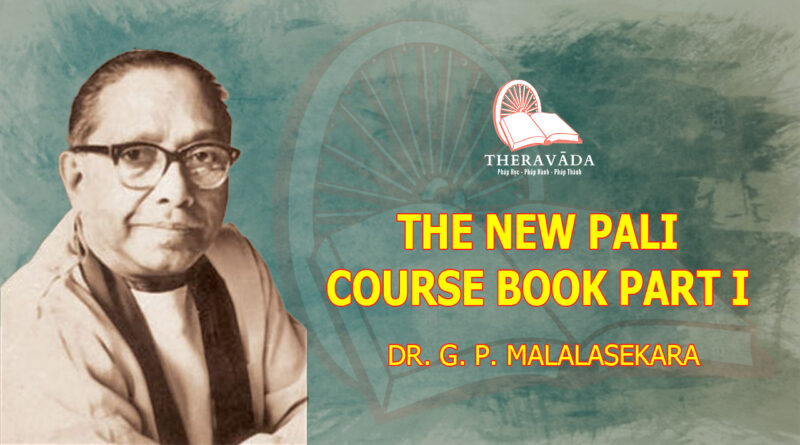The New Pali Course Book
Part I
By Dr. G. P. Malalasekara
University College, Colombo
Foreword
I consider it a great honour that I should have been asked to write this foreword. The eminence of Rev. A. P. Buddhadatta Thera as a scholar is far too well-known in Ceylon and elsewhere for his work to need any commendation from others. His books, particularly the Pālibhāshāvataraṇa, have for many years now been a great boon to students of Pali. The fact that they are written in Sinhalese has, however, restricted their use only to those acquainted with the language. Rev. Buddhadatta has by this present publication removed that disability. As a teacher of Pali, chiefly through the medium of English, I welcome this book with great cordiality for it would considerably lighten my labours. It fulfils a great need and I wish it success with all my heart. I would also congratulate the publishers on their enterprise in a new field.
G. P. Malalasekara.
University College, Colombo.
17th June, 1937.
Preface
Pali is the language in which the oldest Buddhist texts were composed. It originated in the ancient country of Magadha which was the kingdom which was the kingdom of Emperor Asoka and the centre of Buddhistic learning during many centuries. Pali is older than classical Sanskrit, and a knowledge of it is very useful to students of philology and ancient history. It is still the classical language of the Buddhists of Ceylon, Burma and Siam.
During the latter half of the last century some European scholars became interested in the study of Pali and wrote some articles and books to encourage the study of it. At the same time the publication of Pali Texts in Europe was begun through the efforts of Professors V. Fausboll, H. Oldenberg and T. W. Rhys Davids. Thanks to the indefatigable labours of the last mentioned scholar and the Pali Text Society, which he established some fifty years ago, the whole of the Pali Canon (of the Theravāda School) is now found in print.
Pali is now taught in many universities both in the East and the West. There is also a desire all over the civilized world at the present day to read the original Pali Texts in order to find out what the Buddha has preached to mankind 25 centuries ago and to see what historical and philosophical treasures are enshrined therein. Therefore, to facilitate the study of Pali, some modern scholars have compiled Pali courses, grammars and readers according to modern methods. Of these the Pali Grammar by Chas. Duroiselle, formerly Professor of Pali at Rangoon College, still stands unrivalled. Gray’s Pali Course has done much service for a long time to students in India and Burma; and S. Sumangala’s Pali Course has done the same to students in Ceylon.
Although such books were written in European languages hardly any appeared in Sinhalese. Here they studied Pali through books which were written many centuries ago. Therefore, about 1920, when some schools in Ceylon began to teach Pali, the great difficulty before them was the lack of suitable books. Then, requested and encouraged by Mr. P. de S. Kularatna, Principal, Ananda College, I compiled Pālibhāshāvataraṇa (I, Ī, ĪI) in Sinhalese to teach Pali grammar and composition to beginners. It was a success; the demand for the first book necessitated the publisher to
bring out three editions of it within eleven years from 1923 to 1934. (ed. Now it is in the eleventh edition)
Many complimented the work. Recently there came a request from Burma for permission to translate the same into Burmese. Some suggested to me to write it in English as the books already mentioned did not satisfy them; but I dared not to do it as my knowledge of English was insufficient for such a task. But finally I was prevailed upon by Dr. G. C. Mendis to produce this volume.
This is not a literal translation of the Sinhalese edition, but a different compilation on the same lines. To understand the nature of the work it is enough to quote from the report, sent to me by the “Text Book Committee” of the Education Department of Ceylon, on the Sinhalese one: “This is a book for teaching Pali to beginners through the medium for Sinhalese. The method adopted is the modern one of teaching the languages through composition. The lessons are well graded and practical. This supplies a long felt want… We should recommend it for use in schools as an introduction to the study of Pali”.
My thanks are due, first of all, to Dr. G. C. Mendis, who very kindly assisted me in many ways to bring out this volume; secondly to Dr. G. P. Malalasekara, Lecturer in Oriental Languages, Ceylon University College, for his Foreword, and lastly to the Colombo Apothecaries’ Co., Ltd., for the publication of this volume.
A. P. BUDDHADATTA
Aggārāma,
Ambalangoda,
15th June, 1937.
THE NEW PALl COURSE I _ II
TẢI MOBILE APP PHẬT GIÁO THERAVĀDA ĐỂ XEM THÊM NHIỀU THÔNG TIN HỮU ÍCH (ANDROID & IOS)

